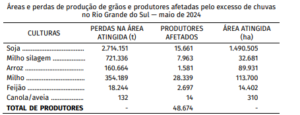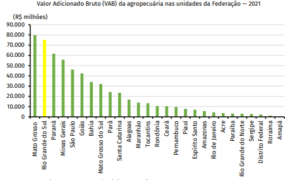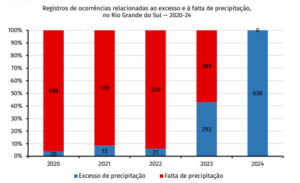Agriculture in Rio Grande do Sul: get to know the Gaucho culture, its challenges and opportunities
Find out more about agriculture in Rio Grande do Sul. See production data, post-flood recovery and projections for future harvests.
September is a festive month in the gaucho culture, as it celebrates the Farroupilha Revolution, which took place between 1835 and 1845. Rio Grande do Sul is rich in traditions that recall its origins, mainly related to its colonizers. Local agriculture was strongly influenced by its immigrants, most of whom were European. Young farmers arrived in the state to cultivate fertile lands, creating a strong base for the local primary sector.
Even today, agriculture is a large part of the gaucho economy. In Rio Grande do Sul, agricultural production represents 40% of the GDP and drives 30% of industrial production. In this text, we will understand the importance of the sector to the state, production and export data, how the recovery after the floods is going, and more. Enjoy the reading!
The Power of Agriculture in Rio Grande do Sul
According to the Agribusiness Panel in Rio Grande do Sul 2024, there are 365,094 agricultural
farms in the state, covering an area of 21.7 million hectares. Of this area, 36% is used for permanent and temporary crops. See more in the data below:
Land Use in Agricultural Establishments in Rio Grande do Sul:

Source: Censo Agropecuário 2017 (IBGE, 2020).
The State of Rio Grande do Sul is the fifth largest economy in Brazil in terms of Gross Domestic Product (GDP). According to IBGE data for 2021, the GDP of RS reached R$ 581 billion, representing 6.5% of the national GDP. The agricultural sector accounted for 14.9% of this data.
In 2023, soybeans were the most produced raw material in the agriculture of Rio Grande do Sul, with almost 13 million tons. See the latest surveys on this sector in the state:

Source: IBGE
In 2021, Rio Grande do Sul contributed 12.7% of the total Gross Value Added (GVA) of Brazilian agriculture. With this performance, the State of Rio Grande do Sul ranks second in the national ranking of agricultural GVA. Between 2010 and 2021, the average share of agriculture in the local GVA will be 72%, in addition to 22% from livestock and 6% from forestry, fishing and aquaculture. See the graph below for more details:
 Source: Sistema de Contas Regionais (IBGE, 2024c).
Source: Sistema de Contas Regionais (IBGE, 2024c).
Rio Grande do Sul also plays an important role in Brazil’s agricultural exports. The state’s well-known importance in exports is directly related to agribusiness. The sector accounted for 72.9% of RS’s total foreign sales in 2023.
According to the RS Planning, Governance and Management Secretariat, the main products exported by RS in 2023 were:
- Soybeans ($4.05 billion);
- Raw tobacco (US$2.29 billion);
- Soybean meal ($1.81 billion);
- Chicken meat ($1.45 billion);
- Grains ($1.41 billion);
- Cellulose ($832.6 million);
- Pork (US$637.4 million).
China is one of the main destinations for Rio Grande do Sul’s agribusiness products in 2024. The Asian country is one of Brazil’s most important trading partners, and the state of Rio Grande do Sul is a major contributor to the nation’s food supply. See other destinations for agricultural products from RS:
- China, with 34.1% of exports;
- European Union, with 12.7% of the exports;
- United States, with 6.2% of exports;
- South Korea, with 3.4% of exports.
Also read:
- Understand the importance of logistics in agribusiness
The impact of flooding on agriculture in Rio Grande do Sul
In May 2024, Rio Grande do Sul faced heavy rains and flooding throughout the state. Entire towns were flooded and crops were completely destroyed, causing severe economic damage.
According to the RS Agribusiness Dashboard 2024, 929 extreme rainfall events were recorded between June 2023 and June 2024. 70% of these events were reported this year, which also affected agricultural crops and harvests. According to the state government, more than 206 thousand rural properties were affected by the floods.
 Source: Sistema Integrado de Informações sobre Desastres (Brasil, 2024c).
Source: Sistema Integrado de Informações sobre Desastres (Brasil, 2024c).
In the agricultural sector, the 2024 Agribusiness Panel reports that the main impacts were recorded in areas planted and not yet harvested from the summer harvest. According to the document, most crops had been harvested before the floods, but the remaining crops were severely affected.
In soybeans, a quarter of the planted area remained to be harvested and the estimated loss in this crop was 2.7 million tons. Corn crops suffered losses in 244 municipalities. In rice, 89,931 hectares remained to be harvested, of which 22,952 hectares were completely lost. See the complete table below:

Source: Emater-RS/Sistema de Levantamento de Perdas (Sisperdas).
Also read:
The prospects of Rio Grande do Sul for the next harvests
Despite the climatic disaster, agriculture in the state of Rio Grande do Sul is already recovering. Conab, in its Grain Harvest Bulletin, predicts a significant increase in grain production in RS, both in the winter and summer harvests. According to the institution, the crops sown within the recommended period have achieved productivity well above average.
The survey also predicts that this agricultural season could be the second largest grain harvest in the State of Rio Grande do Sul, reaching a production of 37.1 million tons. See Conab’s information on the main crops in RS:
Soybeans
Crops with good water supply throughout the cycle. The State has shown a strong recovery in productivity compared to the last two harvests.
Rice
Average productivity was lower than predicted at the beginning of the harvest. However, crops planted within the recommended time period achieved productivity well above average. According to IBGE, Rio Grande do Sul will be responsible for 69.3% of the national rice production in 2024.
Corn
Rio Grande do Sul performed better than the last harvest, with a productivity of 5,952 kg/ha, 32.6% more than in 2022/23. The rains in early September favored the expansion of the planting, which has already reached 37% of the area projected for 2024/2025.
Wheat
The climate after the floods favored the production of wheat in Rio Grande do Sul. The drier days that began in the second half of July provided good phytosanitary conditions for the plants. However, most of the wheat crops are still in the reproductive phase (38% in flowering and 19% in grain filling). In addition, the RS Department of Agriculture reports that 43% of crops are still in vegetative development.
Also read:
- Understand what commodity indices are and how they work
Follow Brazilian Agriculture Reports
Access full reports on Brazilian and global crops on the Hedgepoint HUB portal. You will find complete documents on the world’s major agricultural commodities, expert forecasts, price analysis and more.
Learn more about Hedgepoint HUB and subscribe.








